by Jeffrey
Herman
(click on photos to enlarge image)
BEFORE AND AFTER
I have repaired and reconstructed everything,
from historically important tankards, tea
services and tureens to disposal-damaged and
dishwasher-dulled flatware.
Illustrated are some of the objects I have restored.
This is a large Gorham soup tureen with caved-in
base, dented body and cover.
The piece was in a fire and the soot was fused
to its surface - not a pretty sight...
|
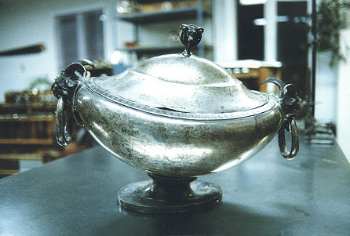
|
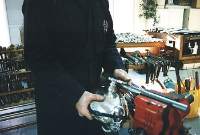
|
The base dents are burnished out. The
process moves from the outside of the base to
the inside, using highly polished steel tools in
various shapes, minimizing any change in the
surface of the tureen.
Since this piece was created in the 19th century,
it's very important to retain the small
scratches and dimples that have accumulated over
the decades...
|
Burnishing out the body dents.
Whenever possible, burnishing is preferable than
hammering because the metal stretches very
little and produces no hammer marks...
|
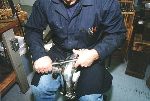
|
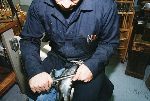
|
The burnishing continues - from the outside
of the piece to the inside-back and forth as
many times as it takes to make surface as smooth
as glass.
This process requires a tremendous amount of
pressure to force the dent back to where it's
level with the surface around it...
|
The body dents are removed with heads that
conform to the compound curve that's being
burnished out.
The head is placed in a horse - a long steel
receptacle which is in turn placed in a heavy
vise...
|
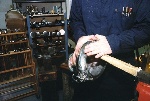
|
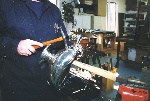
|
Sometimes a highly polished planishing
hammer must be used to force down pinpoint dents
that cannot be removed with burnishers. Rubber,
wooden, or plastic hammers are considered before
resorting to the steel hammer which will remove
the toughest dents, leaving shallow marks that
must be burnished out, filed, and/or buffed ...
|
A wooden hammer is used to remove the edge
dents on the cover, making sure every hammer
blow strikes squarely without distorting the
metal.
A highly polished t-stake is used to back-up the
cover and absorb the blows...
|
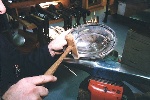
|
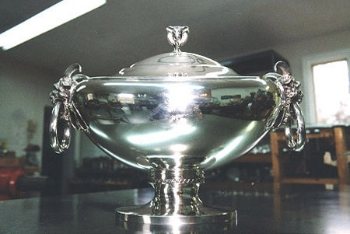
|
The finished piece after 5½ hours of work!
Notice that the monogram on the body remained
intact.
The entire piece was hand finished to look as it
would have before its battering.
The tureen sits atop a surface plate which was
used in conjunction with a height gauge to
insure that the piece is now level.
|
This cruet stand arrived in my shop with one
foot missing. An existing foot was removed,
duplicated with electroforming, and reattached along
with the new foot.
Dents were removed, and even patina was applied,
and the piece was hand finished.
|
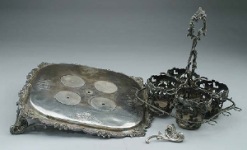
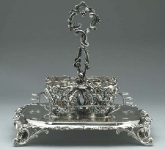
|
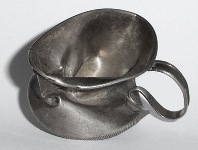
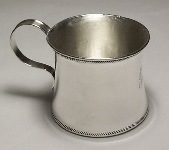
|
This baby cup was actually run over by a
truck in the 1920s. The handle had to first be
removed and reformed. The cup had to be annealed
numerous times to soften the metal, allowing for
the creases to be opened and the body to be
reformed. The imperfections along the hollow top
edge could not be corrected because the metal
was very thin. Any tool used to repair the edge
would result in a poor result, or worse -
tearing the metal! Notice that the engraving on
the right side of the body was preserved. The
90-year-old owner gave the cup to his
granddaughter on her first Christmas.
|
Jeffrey Herman
- 2011 -
|
Jeffrey Herman worked at Gorham as designer,
sample maker, and technical illustrator. Upon
leaving Gorham, he took a position at Pilz Ltd where
he learned the fine art of restoration, and
fabricated mass-produced ecclesiastical ware. He
earned a BFA degree in silversmithing and jewelry
making from Maine College of Art in Portland,
studying under Harold Schremmer and Ernest Thompson,
two outstanding designer/craftsmen. He started his
business in 1984 gaining a national reputation of
quality craftsmanship repairing and reconstructing
everyting, from historical pieces to single spoons.
He is the founder of the Society of American
Silversmiths.
Further details about Jeffrey Herman and information
contact are available in his website at
http://www.hermansilver.com
|
|
|

